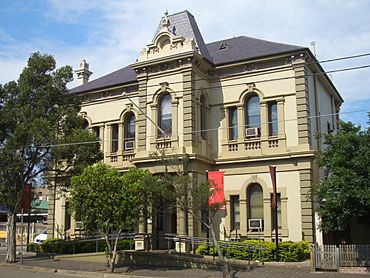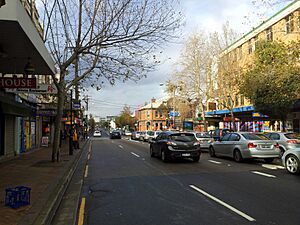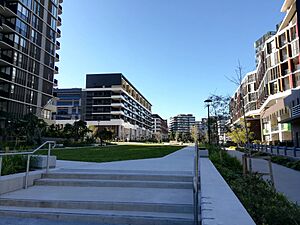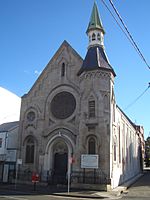Waterloo, New South Wales facts for kids
Quick facts for kids WaterlooSydney, New South Wales |
|||||||||||||||
|---|---|---|---|---|---|---|---|---|---|---|---|---|---|---|---|

Waterloo Town Hall
|
|||||||||||||||
| Established | 1815 | ||||||||||||||
| Postcode(s) | 2017 | ||||||||||||||
| Elevation | 27 m (89 ft) | ||||||||||||||
| Area | 1.1 km2 (0.4 sq mi) | ||||||||||||||
| Time zone | AEST (UTC+10) | ||||||||||||||
| • Summer (DST) | AEDT (UTC+11) | ||||||||||||||
| Location | 3 km (2 mi) South of Sydney CBD | ||||||||||||||
| LGA(s) | City of Sydney | ||||||||||||||
| State electorate(s) |
|
||||||||||||||
| Federal Division(s) | Sydney | ||||||||||||||
|
|||||||||||||||
Waterloo is a suburb located in the inner southern part of Sydney, New South Wales, Australia. It is about three kilometres (1.9 miles) south of the main city centre. Waterloo is part of the City of Sydney local government area. It is surrounded by other suburbs like Redfern, Alexandria, and Zetland.
Contents
Discovering Waterloo's Past
Waterloo got its name from the famous Battle of Waterloo in 1815. In this battle, forces led by the Duke of Wellington and Blücher defeated Napoleon Bonaparte's French army.
Early Industries and Mills
In the 1820s, Waterloo became a place for factories and mills. One important factory was the Fisher and Duncan Paper Mill. This mill, started in 1818, was the first known place to make paper in Australia.
Another key business was the Lachlan and Waterloo Flour Mills. It began in 1820 as a partnership to mill flour. Over time, Daniel Cooper became the main owner. After his death, the land, known as the Waterloo Estate, went to his nephew, also named Daniel Cooper. This younger Daniel Cooper was the first speaker of the New South Wales Legislative Assembly, which is like the state's parliament. Much of this land was later divided up in the 1880s.
In 1974, a group called the Builders Labourers Federation put a "green ban" on the area. This stopped old, affordable homes from being knocked down to build new apartments.
Waterloo Today: Location and Development
Waterloo was traditionally a working-class area. Since the early 2000s, it has been changing. More technology companies are moving in, and new parks are being created. By 2006, the average income in Waterloo was a bit higher than the Australian average.
However, Waterloo still has a large public housing area, shared with Redfern, where about 4,000 people live. These older buildings are planned to be redeveloped. They will become new apartment blocks that mix social housing with affordable housing. A new Metro station is also being built nearby.
The Waterloo Urban Conservation Area has many 19th-century houses. New buildings in this area are encouraged to match the old style.
Green Square Urban Renewal
Green Square is a large project in the south and east of Waterloo and Zetland. This project is turning old industrial areas into new homes and businesses. Many tall apartment buildings with shops on the ground floor have been built near South Dowling Street.
In 2019, the Government of New South Wales shared a big plan for the Waterloo social housing estate. This plan, which will take 20 years, aims to build 6,800 new homes. It includes six tall buildings, some as high as 33 to 40 storeys.
Getting Around Waterloo
Waterloo has good public transport. Buses run to the city centre. Green Square station is in the south-west of the suburb, on the Airport line of the Sydney Trains network. Redfern railway station is also close by, to the north-west.
The new Sydney Metro City & Southwest line, which goes from Chatswood to Bankstown, now includes Waterloo station. This station opened in August 2024. There will also be new shops and homes built around the Metro station.
Places of Worship
Waterloo is home to the city campus of Hillsong Church. Other churches in the area include Grace City Anglican Church, Our Lady of Mount Carmel Catholic Church, Waterloo Congregational Church, South Sydney Uniting Church, and Waterloo Salvation Army.
Who Lives in Waterloo?
In 2021, Waterloo had a population of 16,379 people. This was an increase from 14,616 people in 2016.
About 2.8% of the people in Waterloo are Aboriginal and Torres Strait Islander. Around 37.2% of residents were born in Australia. Other common countries of birth include China (11.5%), England (5.6%), and New Zealand (2.6%).
Most people (45.2%) speak only English at home. Other languages spoken include Mandarin (12.0%), Cantonese (3.0%), and Spanish (3.2%). The largest religions are Catholicism (16.5%) and Buddhism (4.4%). Many people (50.2%) also reported having no religion.
Most homes in Waterloo (91.1%) are apartments. This is much higher than the rest of Australia. Also, 72.7% of homes are rented, compared to 30.6% across Australia.
Fun and Recreation
The Waterloo Skate Park is a modern place for skateboarding. It is designed to look like city streets, similar to popular skate spots in Sydney. The park is next to Waterloo Oval and the Weave Youth Services building on Elizabeth Street.
Notable People from Waterloo
- Samuel George Ball, rugby league administrator
- Fred Chaplin, rugby league player
- Anne Clark, netball administrator and coach
- Claude Corbett, journalist
- Harold Corbett, rugby league player and soldier
- Tom Dadour, doctor and politician
- Dick Daley, rugby league player
- Jim Davis, rugby league player
- Frank Easton, cricketer
- Reta Mildred Findlay, businesswoman
- Edward Hallstrom, businessman
- Edward Hocking, politician
- Perce Horne, rugby league player
- Ernie Hucker, rugby league player
- Vince Hughes, rugby league player
- Rangi Joass, rugby league player
- Jim Kenny, politician
- Perry Keyes, singer-songwriter
- The Kid LAROI, rapper, singer and songwriter
- George Kilham, rugby league player
- Jack Lawrence, rugby league player
- Vic Lawrence, rugby league player
- Elaine Nile, politician
- Syd Price, Australian Rules footballer
- Edward Root, rugby league player
- Alf Sadler, rugby league player
- Eric Spooner, politician
- Clarrie Stevenson, rugby league player
- David Watson, rugby league player
- Frank Wilkins, rugby league player
- Ern Wilmot, rugby league player





